Key Insights
- Orca is a Solana-based automated market maker (AMM) decentralized exchange (DEX).
- Orca has a core focus on user interface, bolstering ease of use and accessibility through human-centered design.
- As the largest pure AMM on Solana, Orca places special emphasis on the composability and simplicity of the AMM and is set up to be a “DeFi lego” (middleware) for the ecosystem.
- Orca recently launched Whirlpools, concentrated liquidity pools akin to those on Uniswap V3, to bolster capital efficiency for liquidity providers and improve execution for traders.
- With the recent launch of Governance v0 and plans to enable community Whirlpool listings, Orca is working towards decentralizing decision making.
To humans, orcas are friendly, accessible, ambassadors for the ocean, but in the marine ecosystem, they are apex predators. As Solana’s automated market maker (AMM) decentralized exchange (DEX), Orca seeks to emulate its namesake by emphasizing superior user experience (UX), capital efficiency, and composability.
Zooming out, DEXs are a centerpiece of the decentralized finance (DeFi) ecosystem. Over 2021, DEX trading volume grew over 800% and surpassed $1 trillion. The most popular type of DEX is the AMM, which relies on mathematical formulas rather than order books to price assets.
Within this large market, Orca differentiates itself by focusing on human-centered design and simplicity. The AMM implements unique features that simplify and improve trading and liquidity provision. Orca also stands out as the first major Solana AMM to roll out concentrated liquidity, improving on the capital efficiency and trade execution of the standard constant product market maker (CPMM). Finally, Orca offers a software development kit (SDK) to further grow its volume and liquidity. Projects across Solana can integrate with the exchange using the SDK. Looking forward, an easy-to-use SDK gives Orca the opportunity to become the Solana ecosystem’s AMM middleware of choice.
Background
Founders Grace Kwan and Yutaro Mori’s extensive technical backgrounds and complementary skill sets led them to develop retail-friendly dApps.
During the summer of 2020, the duo started working on a beginner-friendly interface for Aave’s Ethereum-based lending market, but were quickly discouraged by high gas fees. To make their protocol accessible and profitable for smaller retail users, they needed lower fees. As a result, the team was drawn to the then-embryonic Solana network. By the end of the summer, they secured one of the earliest Solana Foundation grants to build the ecosystem’s first pure AMM-based DEX.
Down the Blowhole
Swaps
Orca’s primary function is to facilitate spot swaps (trades) between certain supported pairs. Currently, the Orca team decides which pairs are listed.
After plugging in a supported wallet, users can see their holdings in Orca’s novel token balance panel. So, while the DEX is non-custodial, this feature allows users to see live balances without having to open browser extensions.
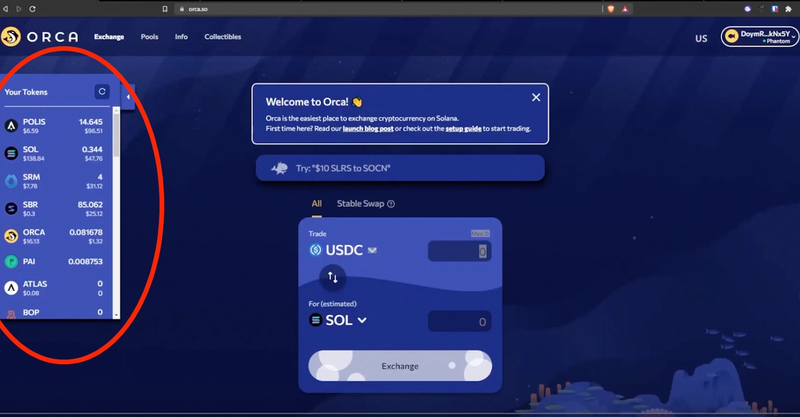
Token balance panel. Source: Orca.so, YouTube
Another unique feature on Orca is the Fair Price Indicator. As users are making their trades, the Fair Price Indicator lets them know:
1) The token price is within 1% of the CoinGecko price.
2) The price impact, the effect of the trade on the market price, is less than 1%.
If either criterion isn’t met, Orca will display a “Rate Warning” for the first condition and a “Price Impact Warning” for the second. Although users can still make their trade, they can use this feature to make their decisions with more certainty and without any extra steps (i.e., checking price trackers or exchanges).
Once a trade goes through, the balances are updated in the token balance panel, and a fee is deducted.
Fees
The Solana transaction fee is a fraction of a cent (<$0.01), charged in SOL. Orca charges 0.3% of the trade value, per constant product liquidity pool involved, as a fee. For Whirlpools the protocol charges 0.26% of the trade value, per Whirlpool involved, as a fee.
For each of these 0.3% swap fees, 0.25% goes to liquidity providers (LPs), 0.04% goes to the Orca Treasury, and 0.01% goes to the Orca Impact Fund. Whirlpools, however, currently don’t take fees for the Orca Treasury (0.04%).
For stablecoins, the trading fees are 0.07% of the trade value, with 0.06% for LPs, 0.008% for the Orca Treasury and 0.002% for the Orca Impact Fund.
The Orca Impact Fund periodically donates the accumulated fees to nonprofits working on ocean conservancy and climate change.
Liquidity
Each Orca liquidity pool is a smart contract that holds reserves of both tokens in a trading pair (e.g., SOL/USDC).
Every two weeks Orca announces its Aquafarm Rotations. In Aquafarm Rotations, LPs can earn extra ORCA rewards in certain pools. ORCA emissions are set by the Orca team to incentivize liquidity to pools with high trading volume-to-liquidity ratios. Some pairs also have “Double-Dip” pools, where users can stake their LP tokens to earn both ORCA and partner project tokens.
Orca is currently rolling out Whirlpools as a second model for providing liquidity. Whirlpools is a concentrated liquidity model, available for select pools, and allows LPs to make markets within any price range. Since they aren’t required to distribute liquidity across the whole price range (from zero to infinity), this method enhances their capital efficiency and fee earning potential.
While Whirlpools do require LPs to manually place liquidity, Orca makes it easier by suggesting preset price ranges with different risk-reward profiles. After depositing liquidity, LPs will receive a Whirlpool NFT to represent the position.
Pricing Curves
Most token pools on Orca still determine pricing algorithmically through a constant product market maker (CPMM). For stablecoins, Orca uses the StableSwap invariant, originally from Curve.fi.
At the moment, some swaps are routed through Whirlpools. Aggregating the different LP positions into a single pool creates a unique, combined curve to trade against. And since this liquidity concentrates around market prices (to earn higher fees), there’s less slippage for traders.
User Interface Design
One aspect that seems to really stand out for users is the aesthetic appeal of the design. This includes the typography, with large, well-spaced, comfortable to read, numbers and letters, unique, well-drawn graphics and a cool color palette.

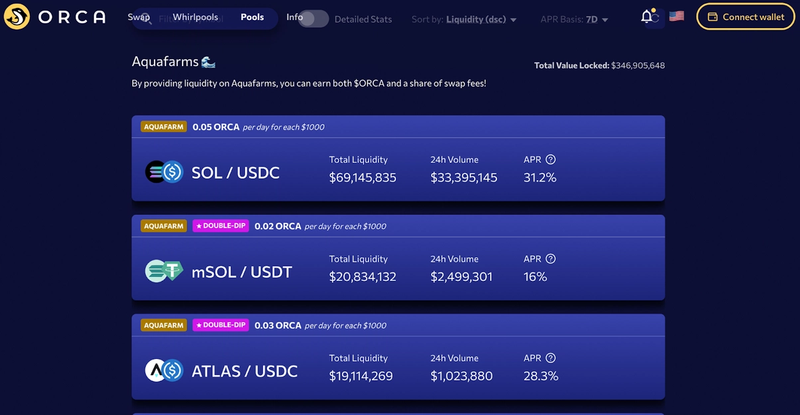
Orca user interface. Source: Orca.so
Most projects either disregard frontend design or tack on generic cyberpunk templates. Orca bucks the trend and drives community engagement through its user-friendly appearance and light, playful tone.
Orcanauts
In late November 2021, Orca launched Orcanauts, a collection of 10,000 whale NFTs. Orcanaut holders are part of the Orcanautical Community and get exclusive access to products (e.g., Whirlpools during closed beta), communication channels, AMAs with the Orca team, and partnerships with NFT brands.
Out of the $1.2 million raised as part of the mint, 75% went to NGO Aflatoun International to develop a crypto and DeFi education curriculum for youth, and the other 25% went to the artists.
Composability
One of the core benefits of AMMs is their composability. In order to become a “DeFi lego,” Orca offers an open-source TypeScript SDK with all the same features as its application. Consistent with the Orca brand, the APIs are meant to be simple and easy to use, allowing developers to integrate, plug into, or build on the exchange’s features (i.e., swaps, liquidity provision, price quotes, etc.). Orca also recently updated its SDK to include Whirlpools.
Some examples of current integrations include swap aggregator Jupiter, portfolio visualization platform Sonar Watch, and yield aggregator Tulip.
ORCA Token
ORCA is Orca’s Solana-based SPL governance token.
Orca’s token launched in August 2021, almost six months after the protocol went live. The initial supply of ORCA, 5.25% of the total supply, was retroactively airdropped to early traders and liquidity providers. 20% of the total supply was allocated to the team, with a 3-year vesting schedule and 1-year cliff. Since the airdrop, ORCA has been used primarily for liquidity incentives (e.g., Aquafarms) and fundraising.
A little over one month after launching the token (September 2021), Orca announced an $18 million Series A led by Three Arrows Capital, Polychain Capital, and Placeholder. Other investors included Jump Capital, Sino Global Capital, Solana Capital, Coinbase Ventures, and DeFiance Capital. These investors received 9.6% of total ORCA supply with a 3-year vesting schedule and 1-year cliff.
The 4.3% for “Value-add + Advisory” is allotted to developers building on top of Orca through the Builders program and subject area experts contributing to the growth of the protocol (e.g., e^{i} Ventures and Reverie).
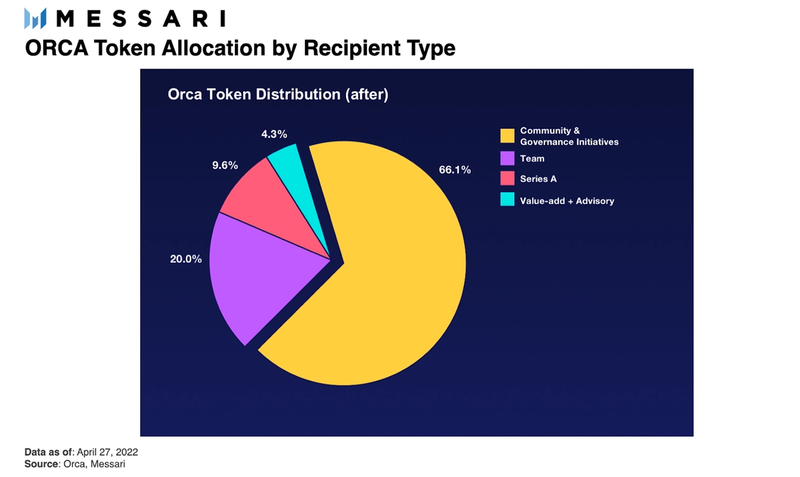
In April 2022, Orca expanded ORCA’s functionality by launching the first iteration of its governance (v0). Up until April, there was only one governance vote. With v0, however, there is now a formal process around community governance. After discussion on the Orca Governance Forum, anyone with 100,000 ORCA can formally submit an on-chain proposal for changes to the protocol. Over a 7-day period, all (unlocked) tokenholders can cast one vote per ORCA. Proposals pass when they have over 500,000 “yes” votes, and are implemented by the Orca team.
Traction
After launching in February 2021, Orca took about six months to gain some traction. Since then, swap volume seems to be running in tandem with the price of Solana (SOL). Over the last six months, the average daily swap volume has been over $50 million.
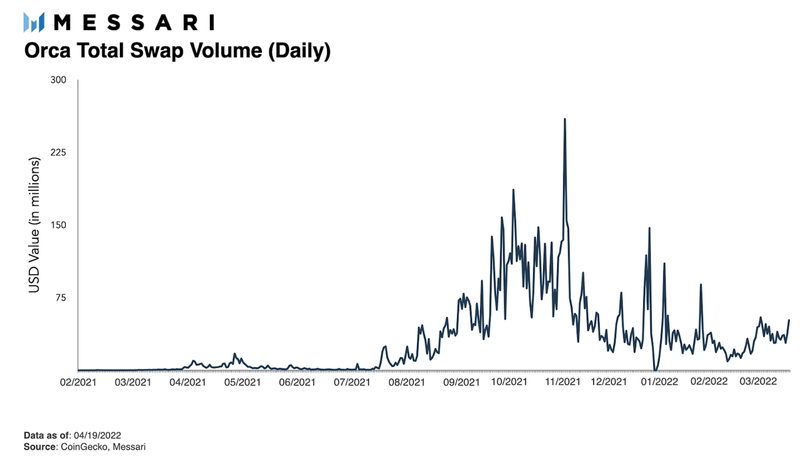
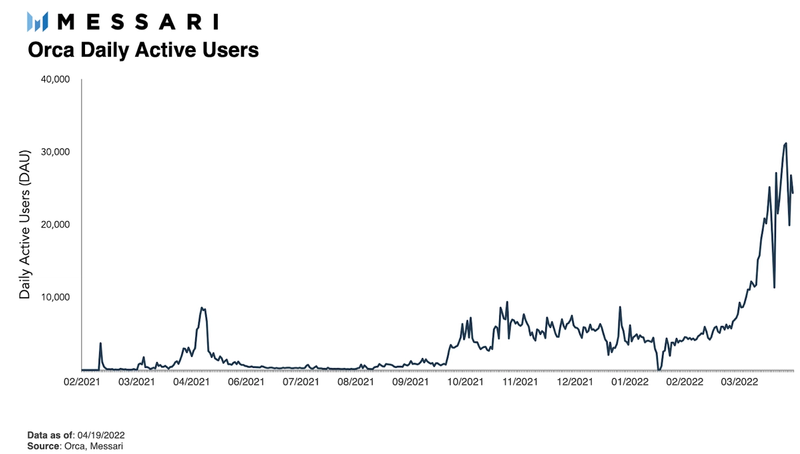
Until recently, daily active users (DAU), measured by unique addresses, moved with swap volume. Starting in mid-March, however, DAU went from hovering around 5,000 to ranging between 20,000 and 30,000. Much of this decoupling seems attributable to STEPN, a lifestyle/exercise dApp that has recently gained traction among retail users.
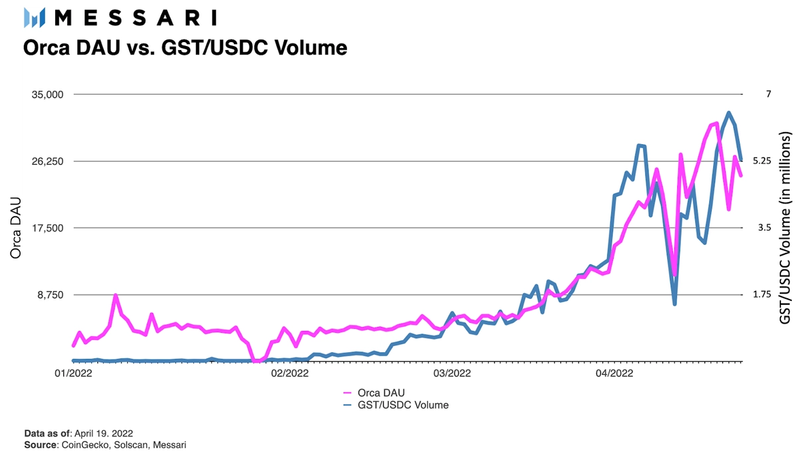
In terms of all-time volume, however, the top two traded pairs are SOL-USDC and SOL-USDT, respectively. Two Ethereum pairs (ETH-USDC and ETH-SOL), a staked Solana pair (mSOL-SOL), and StableSwap routed USDC-USDT are also in the top 10.
Seas Ahead
Migration to Whirlpools
The most notable roadmap item for Orca is the shift to Whirlpools. At first, as concentrated liquidity pools are added, they will run in parallel with the pre-existing constant product liquidity pools. However, constant product pool rewards (Aquafarms and Double-Dips) will gradually turn off and be moved to Whirlpools. Additionally, Whirlpools not taking fees for the treasury will simultaneously increase yields for LPs and lower fees for traders.
Orca also hopes to set up a framework for custom, community Whirlpool listings and launch fee tiers to allow LPs to mitigate volatility/manage margins.
Governance
Orca plans to experiment and customize further in future versions of governance. This includes creating a new, custom governance platform since v0 is a deployment of Realms, Solana’s open-source governance UI. The team also plans on experimenting with parameters such as discussion periods and vote thresholds. Additionally, future iterations may allow proposals to include code that automatically executes with governance approval.
Solana’s DeFi Lego
The Orca team will continue to announce new partnerships as it tries to become the base AMM infrastructure, or middleware, for Solana.
The Food Chain
Orca has two main sets of competitors: pure AMM-based DEXs (such as Uniswap, Curve Finance, and Trader Joe) and Solana-based DEXs (such as Raydium and Serum).
Pure AMMs
As far as pure AMMs go, Orca doesn’t have much competition on Solana. Its cross-chain competition, however, is fierce. Most of the cross-chain competition boils down to network-native liquidity. Some AMMs are dominant on single chains, such as Uniswap on Ethereum, SpookySwap on Fantom, and Trader Joe on Avalanche. Other AMMs are present on multiple chains, such as Curve Finance and SushiSwap.
The chain(s) a project chooses is critical because that determines its total addressable market (TAM). While it’s hard to nail down a given chain’s liquid value, one proxy metric is total value locked (TVL).

Solana ranked third in TVL for much of the latter half of 2021 and has since dropped to fifth. If Orca wants to catch up to leading protocols such as Uniswap and Curve Finance, it needs to go cross-chain, or it needs Solana to attract more tradable volume on-chain.
However, one major advantage for Orca, especially with its new concentrated liquidity pools, are the Solana network’s low fees and fast transaction times. This allows users to quickly and cheaply trade and place/readjust liquidity.
On Solana, Orca’s two main competitors are Serum and Raydium. Even though they are both DEXs, they differ from Orca in meaningful ways.
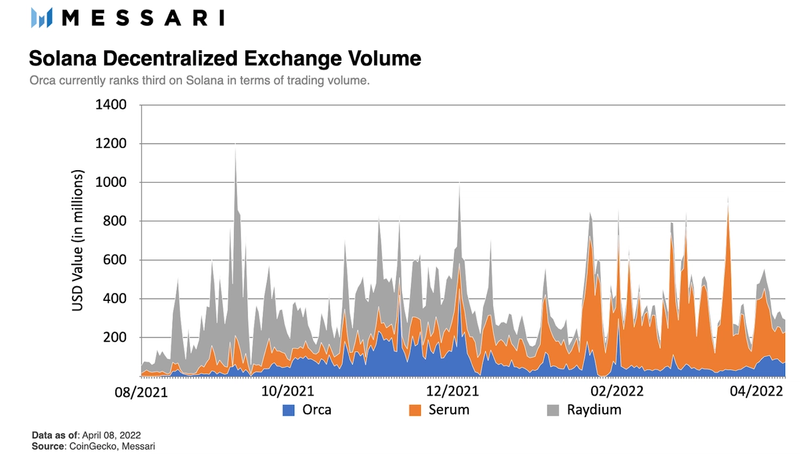
Serum and Raydium
Serum is Solana’s largest DEX by trading volume. It uses a fully on-chain central limit order book (CLOB), and doesn’t have its own frontend. In this sense, Serum isn’t really an exchange at all. Instead, it functions more as an open-source order book middleware, allowing protocols to plug into its liquidity network.
Raydium is the largest AMM on Solana at the moment. It plugs into and provides liquidity to Serum’s open-source CLOB. As a result, Raydium LPs and traders get access to Serum’s cross-protocol order flow and liquidity. The other key differences between Orca and Raydium are their features: Orca is starting to offer concentrated liquidity pools, while Raydium offers two Initial DEX Offering (IDO) platforms and permissionless pool creation.
Raydium’s model seems to offer two ends of the spectrum to LPs. They can either be passive across the whole price curve or actively manage an order book on Serum. Orca’s concentrated liquidity pools offer some of the benefits of both aforementioned models while mitigating some of their drawbacks. Concentrated liquidity gives LPs better capital efficiency and the flexibility to select price ranges based on their willingness to actively manage and risk capital, which results in less potential impermanent loss. For traders, this model reduces slippage over the standard AMM (CPMM). By not integrating Serum, Orca can maintain its sovereignty at the protocol level, in addition to keeping its platform simple.
Closing Thoughts
From both an ethical and market perspective, two of DeFi’s primary objectives are to democratize access and improve the financial experience. Orca lives up to this credo through human-centered design, customizable liquidity provision, and an easy-to-use SDK.
This report was commissioned by Orca, a member of Protocol Services. All content was produced independently by the author(s) and does not necessarily reflect the opinions of Messari, Inc. or the organization that requested the report. Paid membership in Protocol Services does not influence editorial decisions or content. Author(s) may hold cryptocurrencies named in this report.
Crypto projects can commission independent research through Protocol Services. For more details or to join the program, contact ps@messari.io.
This report is meant for informational purposes only. It is not meant to serve as investment advice. You should conduct your own research, and consult an independent financial, tax, or legal advisor before making any investment decisions. The past performance of any asset is not indicative of future results. Please see our terms of use for more information.





















